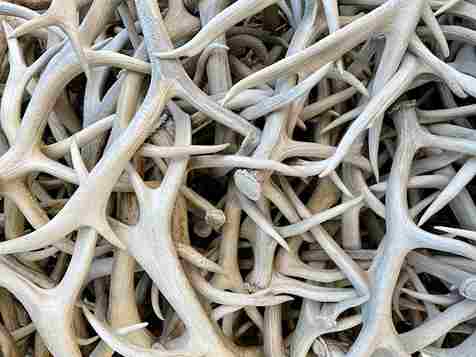What Sound Does An Elk Make?
Elks are social creatures, often found in large herds consisting of cows, calves, and young bulls. Older bulls typically form smaller groups or live solitary lives, joining the larger herds only during the mating season. Their social structure plays a significant role in the sounds and signals they use.
Let’s look at what makes so elks so vocal and the different sounds they produce.

What Does An Elk Sound Like?
Elk have different kinds of vocalizations, and each serves a different purpose, such as socializing, mating, or warning of potential danger.
Here are some of the most common elk sounds:
Bugling
A bugle sound is a high-pitched call used to attract females and intimidate rival males. It’s a very loud noise made by elks during the rut or the mating season and can be heard from a long distance.
Both male and female elk can bugle, but it is more commonly associated with males.
Bugling is used to communicate dominance and warn off potential rivals.
Barking
Another sound elk make is a barking noise.
Elks use barking to warn others of potential threats or danger. It is used as a warning call to alert other elk of potential threats, such as predators or humans.
Mewing
This is a common elk vocalization used primarily by cow elks to communicate with their calves. The mothers use it to maintain close contact with their young.
Both the mothers and elk calves mew to each other. Besides communication, it’s also a way for them to bond. Elk mews are usually soft and high-pitched. It sounds similar to a kitten’s mewing but is usually much louder.
Grunting
Grunting is a low, guttural sound made by both male and female elks. It serves as a form of communication within the herd, often used during social interactions.
Wheezing
Bull elks make this sound during the rut as they challenge each other for dominance. The wheeze is a short, forceful exhale through the nostrils.
Why Do Elk Whistle?
As mentioned earlier, elk use a whistling sound to communicate with each other, especially when alarmed or trying to maintain contact with their herd.
The high-pitched, far-reaching sound allows them to communicate over long distances, such as their location and potential dangers.
Why Do Elk Howl?
Elk howl for similar reasons as they whistle. The howling sound serves to maintain contact with the herd and indicate their location, particularly when visibility is low or in densely forested areas. This haunting sound can travel long distances, making it an effective means of communication.
How Does an Elk Bugle?
An elk bugle is produced when the animal forces air through its vocal cords, creating vibrations that generate sound.
The elk’s nasal passages, mouth, and throat help amplify and modify the sound, resulting in the distinctive bugle call.
The volume, pitch, and duration of the bugle can vary depending on the elk’s intentions and the message they are trying to pass across.
How Loud Are Elks?
Elk are known to be quite loud, with their bugles reaching volumes of up to 115 decibels.
To put this into perspective, this is comparable to the noise level of a chainsaw or a live rock concert. The loudness of an elk’s call allows them to communicate effectively over long distances and intimidate potential rivals.
Does Calling Elk Work?
Yes, calling elk can be an effective way to attract or locate them, especially during the rut.
Using an elk call that mimics the natural sounds they make can draw elk closer, making it easier to observe or hunt them.
However, it’s essential to use the call correctly and practice patiently, as elk can be wary of unfamiliar sounds or overly aggressive calls.
Success with elk calling depends on several factors, such as:
- The quality of the call and how real it sounds
- The user’s technique and understanding of elk vocalizations
- Timing and location (e.g., during the rut when elk are more vocal and responsive)
- Patience and ability of the caller to adapt in the field
For the best elk call, my top recommendation is the Rocky Mountain C6, which also works for moose. But it does require a lot of practice, especially when trying to create bugling sounds with the different reeds.
What Should an Elk Call Sound Like?
An elk call should mimic the natural sounds that elk make, such as bugles, barks, and grunts.
There are various elk calls available on the market, each designed to imitate specific elk sounds.
Whether you’re using an elk call for hunting purposes or simply want to observe these magnificent animals, it’s essential to choose a call that produces realistic and effective sounds.
How Do You Growl on an Elk Call?
To produce a growl on an elk call, follow these steps:
- Choose the right call: Opt for an elk call designed to produce a variety of sounds, including growls. Diaphragm calls, also known as mouth calls, are particularly versatile and can help create realistic growls.
- Position the call: If using a diaphragm call, place it in your mouth with the latex reed facing upward and the open end of the horseshoe-shaped frame pointing toward the back of your mouth.
- Apply pressure: Apply gentle pressure with your tongue to the latex reed and hold it against the roof of your mouth.
- Control airflow: Inhale deeply and exhale through the diaphragm call, controlling the airflow to create vibrations in the latex reed. To produce a growl, use a low, steady pressure and adjust the pitch by changing the position of your tongue.
- Practice: Spend time practicing your growl technique to achieve a realistic and effective sound. Try to imitate the natural growls of elk and refine your technique based on your observations.
In Conclusion: Do Elk Make Noise?
Elk make different sounds, such as bugling, whistling, barking, mewing, and wheezing. Each of these sounds serves different purposes.
For hunters, mastering elk calls can significantly improve your chances of success in the field. By imitating the natural sounds that elk make, you can attract them to your location or even manipulate their behavior to create better opportunities for a clean and ethical shot.






